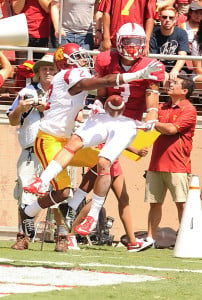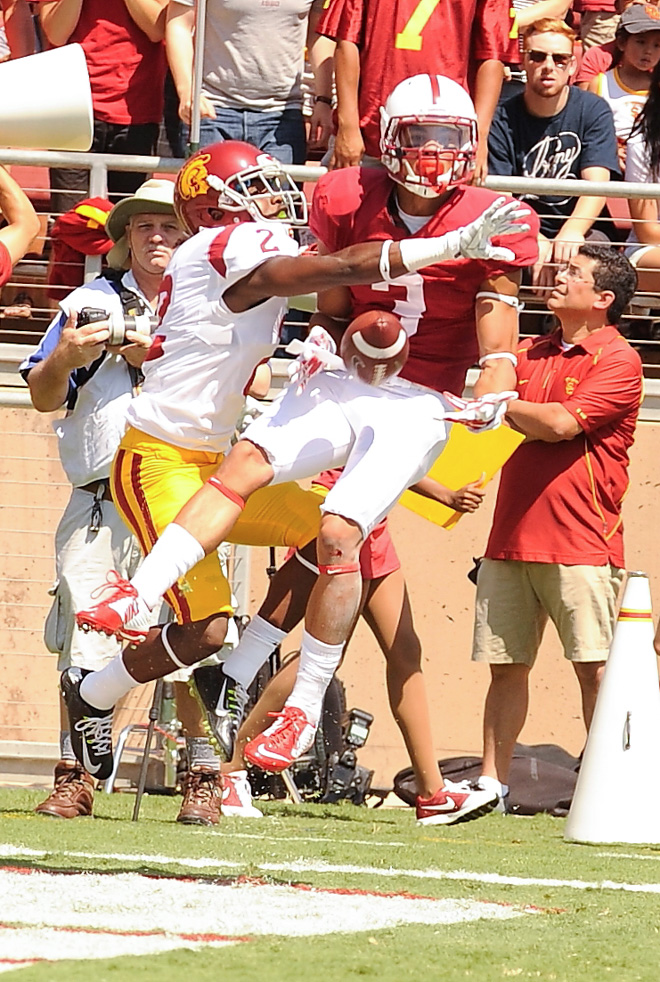Washington (3-3, 1-2 Pac-12) vs. No. 10 Stanford (5-1, 4-0 Pac-12)
Michael Peterson: Stanford 35, Washington 12

Ponder this for a minute: Since Michael Rector caught Kevin Hogan’s flea-flicker pass for a touchdown, Stanford has scored a touchdown on 30 of its 51 drives, excluding drives which resulted in the end of a half due to time expiring. That means that 59 percent of the time that Stanford gets the ball, it scores a touchdown. Last year, Stanford scored touchdowns just 54 percent of the time it entered the red zone. That’s how monumental this offensive improvement has been. Though Washington statistically boasts the Pac-12’s best defense, allowing just 16.8 points per game, it will have a tough time stopping Stanford enough for its sporadic offense to compete. Stanford manages “just” 35 points, but the defense continues producing big plays after 2 interceptions and 8 tackles for loss against UCLA and helps set the offense up for easy scoring opportunities.
Do-Hyoung Park: Stanford 20, Washington 6
I am 100 percent sold on Washington’s defense. If you’re going to hold Oregon to 26 points (allowing just 3.3 yards per carry) and USC’s overwhelming talent to 12 points, you’re doing something right. Washington plays a very cohesive, team-oriented defense much in the mold of Stanford’s and has been exceptionally stiff against the run. Granted, the Huskies haven’t faced an offensive line as good as Stanford’s yet, but there’s only so much I can see them caving in, even against McCaffrey and the Tunnel Workers’ Union. That secondary isn’t all too shabby either, having allowed less than 6 yards/attempt in four games this season as well. In one of those games, they also picked off Cody Kessler, one of the nation’s most risk-averse quarterbacks. Twice. The only reason I have Stanford winning this game comfortably is because Washington quarterback Jake Browning suffered an injury to his throwing arm, meaning that it’s either a hurt Browning or an unconvincing K.J. Carta-Samuels leading a very, very young offense that has already struggled to stay on the field. Stanford’s defense smothers Washington’s offense en route to an ugly, ugly win.
Andrew Mather: Stanford 45, Washington 10
If you think hard enough, there are all kinds of possibilities for why the Cardinal might struggle in this game. Forget them all. This season for Stanford has become the year of Occam’s Razor, in which the Cardinal’s potential actually aligns with their performance. As Michael mentioned, Stanford is just using too many threats too effectively to be brought down by this young Washington team, and I don’t expect to see too much of a dropoff in performance as Stanford goes through yet another iteration of #pac12afterdark.
It’s a testament to how deep this Stanford attack is that talented and experienced football players like Devon Cajuste are practically afterthoughts in Stanford’s current scheme, and I cannot imagine that the Huskies’ counterparts will manage to keep pace for long. Washington’s impressive early-season defensive proficiency, meanwhile, has mostly been a result of chewing up weak offensive lines and pressuring quarterbacks, something that I don’t see happening against a unit that makes allowing two sacks look like a huge disappointment. Chris Petersen’s play-calling keeps it close in the first quarter but the Huskies start to go quiet as the clock keeps ticking. Christian McCaffrey records yet another 300 all-purpose yards before Keller Chryst shuts it down as Stanford cruises to yet another blowout victory.
Vihan Lakshman: Washington 17, Stanford 10
As Do pointed out above, the Huskies’ defense is extremely stingy, leading the Pac-12 with only 16.8 points allowed per game. Despite losing three NFL first-round picks and appearing undersized on paper, Washington boasts a physical unit that has rendered even the mightiest of Pac-12 offenses, such as USC, completely helpless. We saw what a talented defense in Northwestern could do in knocking Stanford off its rhythm and shutting down the run, forcing the Cardinal into third-and-long situations. Washington’s stout front has all the tools to shut down Stanford’s prolific running game and force the Cardinal to try to win this game through the air, where a ball-hawking secondary that has picked off nearly twice as many passes as it has allowed passing touchdowns, awaits. Washington’s ability to force turnovers ultimately makes the difference in this defensive struggle as the Huskies’ offense receives the gift of short fields to work with, something the team can exploit regardless of who plays at quarterback.
